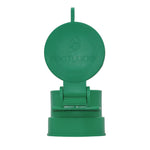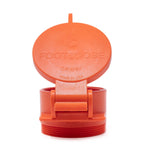You have no items in your shopping cart.
As a homeowner, you want nothing more than for all areas of your property to remain in pristine condition. However, certain areas require more care and caution than others to maintain—especially your sewer system.
On a residential lot, your sewer system is intended to safely collect and dispose of used water, but if you aren’t prepared to handle the worst, this imperative function could come to a standstill. At the end of your sewer system is a sewer cleanout cap , which serves to provide easy access for licensed plumbers to inspect and repair your sewer system.
When your sewer cleanout cap gets damaged—or worse, goes missing—you could face a multitude of issues. Your sewer pipe cap may even pop off unexpectedly, leaving your sewer line exposed to foreign objects and conditions that could easily cause major problems down the road.
A maintained sewer system requires decent knowledge to ensure the system is able to perform its basic functions. To help keep your sewer system safe and functioning properly, this article will explain the fundamentals of how to fix a broken sewer pipe cap.
Why Do Sewer Cleanout Caps Break?
It can be nerve-wracking when things start to go wrong with your sewer system unexpectedly, which is why it’s important for homeowners to be aware of the following ways a sewer pipe cap could be damaged.
1. Rusting and Corrosion
As your sewer pipes get older and are exposed to outdoor elements such as rain and freezing weather conditions, they are more prone to rust, and from this comes the threat of corrosion. The same goes for sewer pipe caps, which can fuse shut if the cap has rusted.
You’ll notice when your sewer cap has been fused shut if you are unable to screw it open on your own. If elbow grease doesn’t work, it’s time to look for other solutions or seek out a professional who can show you how to fix a broken sewer pipe cap.
2. Loose Sewer Cap
It’s not uncommon for homeowners to leave their sewer caps loose during installation. Although rare, some municipalities may even require that homeowners leave their caps loose so that in the case of flooding, sewage runs out into the yard rather than inside your home.
If your sewer pipe cap is loose, factors like built-up pressure, gasses, or strong winds could end up popping it off, leaving your pipes exposed. To prevent flooding and severe damage to your yard or pipes, sewer pipe caps should always be tightened unless otherwise directed.
3. Lawnmower
When you’re mowing your lawn, it’s easy to become distracted and not realize you’ve accidentally run over your sewer pipe cap. When this happens, your sewer pipe cap could become chipped, or parts of it could go missing, meaning a replacement may be necessary.
How to Know Your Pipes Have Been Damaged
The longer you leave a broken or missing sewer pipe cap to linger, the more likely your sewer line is to face damage. If you noticed your broken sewer pipe cap too late, there are ways to tell if your pipes have already taken consequential damage.
1. Flooding or foul odors
If you notice some unpleasant odors or an overflow of sewage water in your yard, this could be the result of a broken sewer pipe. With sewer lines that are closer to the surface, a broken pipe can quickly begin pooling water into the soil and become visible on your lawn. At times, you’ll be able to catch scents of the sewage gas before the flooding is visible, indicating an issue with your plumbing.
2. Slow-to-drain plumbing
A clog in your sewer line can result in baths, sinks, and toilets in your home taking much longer to drain than normal. Before you get to work on fixing your plumbing, it’s important to distinguish whether this clog is coming from a pipe leading directly from a faucet or shower or if it’s from the main sewer line. You can detect the latter if multiple drains in the home are clogging rather than just one.

How to Repair a Broken Sewer Cleanout
If your sewer pipe cap is broken, loose, or stuck, there are ways to combat the issue on your own or with a licensed plumbing professional. Here are the steps to repair or replace a broken sewer cleanout:
1. Locate the crack on the sewer cleanout
The first step to repairing your sewer cleanout is finding your area of repair. If you find that the only portion broken is the cap, you can replace the plug by unscrewing it from the top of the cleanout. However, if the broken portion is below the ground’s surface, use a shovel to dig down until that area is completely exposed.
2. Cut the cleanout pipe two inches below the crack
Using a pipe saw or hacksaw, cut the cleanout pipe two inches below and two inches above the crack. Once cut, dispose of the broken section of pipe and set the top section of the pipe (which is attached to the plug) aside for later. Then, using a brush or towel, brush the dirt off of both ends of the sewer cleanout pipe that will be reattached using a coupling.
3. Use a swab to primer the end of the cleanout
With a swab, primer the exterior rim of the cleanout pipe that’s still in the ground and then once more to the inner wall of one end of the coupling. Then, coat the primer on the pipe and inside the coupling with cement glue. You should be able to slide the coupling over the pipe’s end and twist it. Hold in place for at least 10 seconds.
4. Use primer on the threaded pipe attached to the coupling and cap
Repeat Step 3 with the above-ground portion of the sewer cleanout cap. Prime and glue the coupling to the original sewer cleanout pipe that you set aside in Step 2. Hold in place for at least 10 seconds. As a final step, ensure the cleanout cap is still tightly screwed onto the pipe.
Protecting Your Sewer Line
Your sewer system requires precise care and maintenance, enabled by your sewer cleanout access. Ignoring a broken sewer cleanout cap could cause severe damage to your sewer system in the long run. This means plumbing issues, however minor they may seem, should be taken care of as soon as possible.
If you are looking for more information on sewer systems, such as how to replace a broken sewer cleanout cap or repair your sewer line, start by reading our blog post on how to find the right plumbing pipes.









